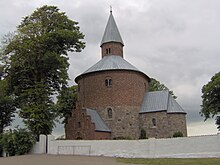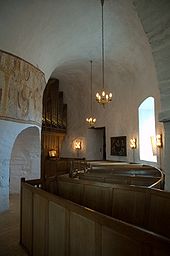Nordic round churches
The Nordic round churches are sacred central buildings ( round churches ) that are found in Denmark and Scandinavia ( Sweden and Norway ).
Function and architectural role models
According to a general interpretation, Nordic round churches were oriented towards defense in their function. Apart from their religious function, they also served as a symbol of power, as a warehouse and storage facility, and to protect parishioners in regional conflicts. Even if, from an architectural point of view, it is not always possible to clearly assign the churches still preserved today to defensive structures, many historians are of the opinion that the round churches of the north were built as a combination of defensive structures and places of worship. Since stone buildings were still rare in the 12th century and there was little experience in defending or attacking them, it was often decided in crisis areas to build a combination of both buildings instead of a castle and an ordinary church. Ordinary oblong churches of the 12th century were also built in such a way that the doors could be locked from the inside with heavy crossbars that could be inserted into deep cavities on either side of the door. Round churches also often had the option of defending the doors from above. In general, the round building shape supports the defense, because the defender has a better all-round view and it does not allow the attacker to see any secluded areas.
The round shape is believed to have originated from Neolithic and ancient tombs and temples. The extension of the central space around a central central axis is characteristic of round churches. When the room is entered, one stands in the middle of the room, which simplifies presence, communication and thus participation in church activities.
In the early research on round churches, an architectural connection to the church of the Holy Sepulcher in Jerusalem was often drawn. This theory is still held by many researchers today. In addition to the church shape, there are z. B. in the church of Vårdsberg a number of niches, which show clear parallels in their arrangement to the Holy Sepulcher in Jerusalem. This architectural analogy has a long tradition in Europe. Well-known buildings from which one can assume such an architectural connection to the Church of the Holy Sepulcher are the Basilica of San Vitale in Ravenna, the Hagia Sophia in Istanbul and the Palatine Chapel of Charlemagne in Aachen. In addition, on the European continent round buildings such as bsw. the pantheon, converted into Christian churches. Archaeological research suggests that a large number of Christian sacred buildings were created by converting pagan buildings and temples. Furthermore, the Nordic round churches show strong German and West Slavic influences. Especially in the case of the round churches on Bornholm, these consist of German influences, while those of the Swedish round churches are more of West Slavic origin. Evidence of these influences up to the round church of Orphir on Orkney is evidence of an unusual cultural exchange even over great distances at that time.
Denmark
The most famous round churches in Denmark that have survived to this day ( Danish rundkirke ) are located on the island of Bornholm . They were made in the 12th century, an exact date is not known. They have been rebuilt several times. Their specialty lies in their fortress-like reinforced outer walls with large buttresses , which, together with a central pillar , carry the load of the surrounding barrel vault. With the exception of Ny Kirke, Bornholm's round churches are counted among the fortified churches . Their central pillars are often decorated with a picture frieze. Originally, the circular buildings had flat roofs and encircling battlements (for defense). They only got their characteristic conical roofs in the late Middle Ages. They pressed with their weight on the outer walls and made the mighty outer supports necessary, which particularly shape the image of the church of Østerlars. The churches of Olsker, Nylars and Østerlars have three floors, the Ny Kirke two floors. The upper floors can only be reached through narrow staircases and were used by the population as protection rooms against attacking pirates.
The other three Danish round churches are on Jutland and the islands of Funen and Zealand . What they have in common is that they do not have any reinforced outer walls. They have a vaulted ceiling supported by four central pillars. After the Archbishop Absalon von Lund they are called "Absalon Round Churches". Absalon was a member of the Zeeland aristocratic and bishop's family Hvide, to which the builders also belonged. All three buildings are based on the same floor plan, which is derived from the round field stone church in Schlamersdorf in Wagrien , which was destroyed by fire in 1870 . The round church in Petersborg, north of Sorø on Zealand, which was replaced by a new building in the Middle Ages , was also built according to this model.
- Round churches in Denmark
- Saint Ols Church in Olsker - Bornholm
- Nylars Church - Bornholm
- Ny Kirke - Bornholm
- Østerlars Church - Bornholm
- Bjernede Church - Zealand
- Horne Kirke - Funen
- Thorsager Church - Jutland
A round church that no longer exists in the Danish sphere of influence was St. Michaelis auf dem Berge in Schleswig , which was built as a monastery church in the 12th century and continued to be used as a parish church after the dissolution of the convent in 1192. After several modifications and additions in the following centuries, it collapsed in the 1850s and was demolished in 1870.
Sweden
In Sweden only eight round churches ( Swedish rundkyrka ) have survived to this day. Of five other only ruins or foundation walls still exist. Some were replaced by newer buildings. They are among the oldest religious buildings in Sweden and date from the 12th to the early 13th centuries. The sacred central buildings later built in Sweden are also reminiscent of these round churches, such as the Trefaldighetskyrkan in Karlskrona and Skeppsholmskyrkan (Karl Johans kyrka) and Katarina kyrka in Stockholm . Not least because of the excavation work on the ruins in Klosterstad, however, interest in archaeological research for further locations was rekindled.
- Round churches in Sweden (Rundkyrkorna)
- Bromma Church - Stockholm Province
- Solna Church - Stockholm Province
- Munsö Church - Stockholm Province
- Hagby Church - Kalmar Province
- Voxtorp Church - Kalmar Province
- Vårdsberg Church - Östergötland Province
- Tjärstad Church - Östergötland Province
- Valleberga Church - Skåne Province
- Skörstorp Church - Västra Götaland Province
- Helsingborg round church - Skåne province
- Agnestad church ruins - Västra Götaland province
- Church ruins of Klosterstad - Province of Östergötland
- former church of Dimbo-Ottravad - Västra Götaland province
Norway
The only round church ( Norwegian rundkirke ) is in ruins in Tønsberg , Norway's oldest city. It was part of a medieval monastery of the Premonstratensian order . Its construction began in the second half of the 12th century, completed in 1191 and dedicated to Saint Olav. The choice of a round church as a monastery church is considered unique. In addition, it was probably the largest round church in Scandinavia in terms of its dimensions. The cult of St. Olav , which continues to this day, could serve as an explanation for this size . Just a few years after her consecration, in March 1207, King Erling Magnusson Steinvegg was buried in her . In 1536, four years after the monastery was secularized , the complex burned down. However, some parts of it could be rebuilt and have since been used as a feudal residence.
- Round churches in Norway
- St. Olav Monastery Church in Tønsberg - Vestfold Province
See also
Individual evidence
- ↑ Agnes Geijer, Anne Marie Franzén and others: Drottning Margaretas gyllene kjortel i Uppsala domkyrka. Kungl. Vitterhets-, historie- och antikvitetsakademie, Stockholm, 1994, p. 7.
- ↑ Is Vienna Berg: Kirkerne og befolkningen i Ystadområdet. from: By, huvudgård och kyrka: studier i Ystadsområdets medeltid . Almqvist & Wiksell International, Stockholm, 1989, pp. 243-264.
- ↑ M. Olausson: Det inneslutna rummet - om kultiska hägnader, fornborgar och befästa gårdar i Uppland from 1300 f.Kr till Kristi födelse. Riksantikvarieämbetet Arkeologiska undersökningar Skrifter nr 9. Stockholm, 1995
- ↑ Ann Catherine Bonnier, Ingrid Rosell: Enkopings Kyrkor. Almqvist & Wiksell International, Stockholm, 1984
- ^ Rikard Hedvall: Kyrkorna i Klåstad. from: Människors rum ochomanniskors would like: kulturhistoriska skisser . Berit Wallenbergs stiftelse, Stockholm 2007.
- ↑ Hugo F. Frölén: North befästa rundkyrkor: en Konst- och Kulturhistorisk undersökning. Lars Frölén, Stockholm 1911, p. 12f.
- ↑ E. Wrangel: Skandinaviska förbindelser med de västslaviska Folken under äldre medeltiden. Tidskrift för konstvetenskap, 1935, p. 117.
- ↑ Rikard Holmberg: Ett skånskt spridningscentrum för bysantinska culture impulser. from: Fornvännen årgång 1970 . Digital Fornvännen, Riksantikvarieämbetet, Vitterhetsakademiens bibliotek, Stockholm, 1970, pp. 120–135.
- ↑ a b Hans Klüche, Bornholm , Goldstadt Travel Guide, 1993.
- ↑ Arne Rohde: Sct. Laurentius kirke: Østerlars sogn, Bornholm. Colbergs boghandel, Rönne, 1934
- ^ Hermann Hinz: The east Scandinavian fortified churches . In: Chateau Gaillard: études de Castellologie médiévale. University of Caen. Center de recherches archéologiques médievales p. 165ff.
- ^ Pastor R. Christensen, St. Ols Church , 1997.
- ↑ Ulla Kjær: Pedersborg Kirke , in: Den Store Danske , Gyldendal
- ↑ Hans Nicolai Andreas Jensen , Andreas Ludwig Jacob Michelsen (ed.): Schleswig-Holsteinische Kirchengeschichte Vol. 2, Kiel 1973, pp. 262f
- ↑ Hugo F. Frölén: North befästa rundkyrkor: en Konst- och Kulturhistorisk undersökning. Lars Frölén, Stockholm 1911, p. 158.
- ^ Website of the Catholic Church of Norway
- ↑ Website of the Premonstratensian Order with picture archive ( Memento of the original from April 8, 2008 in the Internet Archive ) Info: The archive link has been inserted automatically and has not yet been checked. Please check the original and archive link according to the instructions and then remove this notice.
literature
- Ann Catherine Bonnier, Göran Hägg, Ingrid Sjöström: Svenska kyrkor. En historisk reseguide. Medström bokförlag, Stockholm, 2008 ISBN 978-91-7329-015-9 .
- Hugo F. Frölén: Nordens befästa rundkyrkor: en konst- och kulturhistorisk undersökning. Lars Frölén, Stockholm 1911
- Rikard Hedvall: Kyrkorna i Klåstad. from: Människors rum ochomanniskors would like: kulturhistoriska skisser . Berit Wallenbergs stiftelse, Stockholm 2007.
- Rikard Hedvall, Karin Lindeblad: Det medeltida Östergötland. En arkeologisk guidebok. Historiska Media, Lund 2007.
- Rikard Hedvall, Helmer Gustavson: Rundkyrkan i Klosterstad - in presentation of ett pågående project. Fornvännen årgång 1996 (PDF; 1.1 MB). Digital Fornvännen, Riksantikvarieämbetet, Vitterhetsakademiens bibliotek, Stockholm, 2001 pp. 145–152.
- Rikard Holmberg: Ett skånskt spridningscentrum för bysantinska cultural impulses. from: Fornvännen årgång 1970 (PDF; 2.1 MB). Digital Fornvännen, Riksantikvarieämbetet, Vitterhetsakademiens bibliotek, Stockholm, 1970 pp. 120–135.
- Hermann Hinz : The East Scandinavian fortified churches. In: Chateau Gaillard: études de Castellologie médiévale. University of Caen. Center de recherches archéologiques médievales 1983, ISBN 2-902685-01-7 .
- Friedrich Laske: The round churches on Bornholm and their medieval picture decorations. 2005, ISBN 3-9808983-8-5 (facsimile of the original edition from 1902)
- Peter Eriksson Lindskog: Försök till en korrt deskrifning om Skara pen. 5 single issues, 1812–1816, facsimile from 1985
- Erik Lundberg: Östergötlands romanska landskyrkor. 1927
- Torsten Mårtensson: Borg och rundkyrka. Stockholm, 1936
- Jørgen Rasmussen: Thorsager Rundkirke - Gennem 800 År. Bog om kirkens history and inventory. Thorsager menighedsråd, 1999
- Leif Törnquist: Svenska borgar och fästningar - En historisk reseguide. Värnamo, 2007











